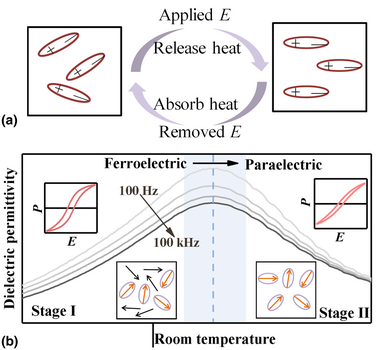Crossref Citations
This article has been cited by the following publications. This list is generated based on data provided by
Crossref.
Zhang, Shujun
Malič, Barbara
Li, Jing-Feng
and
Rödel, Jürgen
2021.
Lead-free ferroelectric materials: Prospective applications.
Journal of Materials Research,
Vol. 36,
Issue. 5,
p.
985.
Tao, Hong
Yin, Jie
Zhao, Chunlin
Wu, Bo
Zhao, Lin
Ma, Jian
and
Wu, Jiagang
2022.
Large electrocaloric effect under electric field behavior in potassium sodium niobate ceramics with incompletely overlapped phase boundaries.
Journal of Materials Chemistry A,
Vol. 10,
Issue. 10,
p.
5262.
Wang, Yanyu
Zhu, Lipeng
Zhao, Ye
Li, Yong
and
Hao, Xihong
2022.
Enhanced electrocaloric effect in lead-free ferroelectric potassium–sodium niobate ceramics benefiting from phase boundary design.
Journal of Materials Science: Materials in Electronics,
Vol. 33,
Issue. 21,
p.
17322.
Kacem, Hend
Dhahri, Ah.
Aouaini, F.
Sassi, Z.
Seveyrat, L.
Lebrun, L.
and
Dhahri, J.
2022.
Enhanced electrocaloric effect, energy storage density and pyroelectric response from a domain-engineered lead-free BaTi0.91Sn0.08Zr0.01O3 ferroelectric ceramic.
RSC Advances,
Vol. 12,
Issue. 47,
p.
30771.
Tao, Hong
Yin, Jie
Zhao, Lin
Wu, Bo
Ma, Jian
Ergu, Daji
and
Wu, Jiagang
2022.
Positive and negative electrocaloric effect in the direct and indirect characterization of NaNbO3-based ceramics with tetragonal–cubic phase boundary.
Journal of Materials Chemistry C,
Vol. 10,
Issue. 45,
p.
17099.
Najm, Noor
Ataiwi, Ali H.
and
Anaee, Rana A.
2022.
Annealing and Coating Influence on the Mechanical Properties, Microstructure, and Corrosion Properties of Biodegradable Mg Alloy (AZ91).
Journal of Bio- and Tribo-Corrosion,
Vol. 8,
Issue. 2,
Huang, Xiaolin
Tan, Peng
Wang, Yu
Zhang, Yao
Wen, Xing
Wang, Guanchao
Zhou, Zhongxiang
and
Tian, Hao
2022.
Enhanced Electrocaloric Effect Induced by the Electric-Field-Generated Like-Multiphase Coexistence in Anisotropic KTa1–xNbxO3 Single Crystals.
Crystal Growth & Design,
Vol. 22,
Issue. 5,
p.
3485.
Meier, Janet M.
Caris, Josh
and
Luo, Alan A.
2022.
Towards high strength cast Mg-RE based alloys: Phase diagrams and strengthening mechanisms.
Journal of Magnesium and Alloys,
Vol. 10,
Issue. 6,
p.
1401.
Ahmed, Mohammed Abdulateef
2023.
Investing the selective corrosion in zinc metal recovery produce zinc phosphate that used in dental to fillers.
Vol. 2797,
Issue. ,
p.
060013.
Zhang, Wenzheng
Zhang, Tingting
Huang, Li
Cui, Cankui
and
Wang, Zan
2023.
Plasticization and reinforcement behavior of low viscosity benzoxazine prepolymers for neoprene rubber.
Journal of Polymer Research,
Vol. 30,
Issue. 3,
Li, Feng
Liu, Wei
Ma, Jianxing
Long, Mingsheng
Lou, Xiaojie
Li, Kai
Wang, Chunchang
and
Shan, Lei
2023.
Antiferroelectric orthorhombic P-to-R phase transition induced exotic electrocaloric effect in NaNbO3-based lead-free ceramics.
Applied Physics Letters,
Vol. 122,
Issue. 9,
Huang, Yuntao
Xue, Haoyue
Zheng, Ting
and
Wu, Jiagang
2023.
Enhanced pyroelectric performance in potassium sodium niobate‐based ceramics via multisymmetries coexistence design.
Journal of the American Ceramic Society,
Vol. 106,
Issue. 2,
p.
1113.
Hong, Wei
Wu, Haiyan
Li, Wenjie
Huang, Fangping
Wang, Ming
and
Shen, Ding
2023.
Preparation and characterization of antibacterial and antiviral nano functional agent HXG-36-8.
Ferroelectrics,
Vol. 609,
Issue. 1,
p.
103.
Zhang, Wei
Zhao, Jingjing
Gui, Huahua
Zhang, Tingting
and
Mou, Jiangnan
2024.
The influence of phenolic resin modified by cardanol on improving the processability of PVC.
Journal of Elastomers & Plastics,
Vol. 56,
Issue. 2,
p.
93.
Zhang, Guangzu
Zou, Kailun
and
Jiang, Shenglin
2024.
Piezoelectric Materials.
p.
423.






